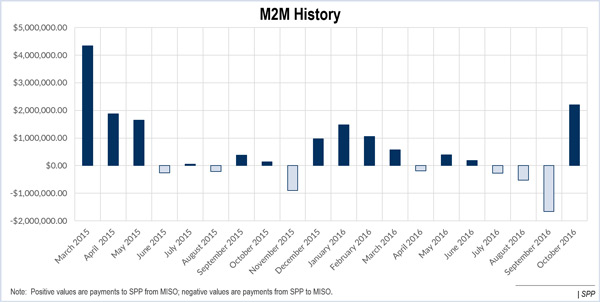SPP says it has successfully implemented system changes required by FERC Order 809, which ordered RTOs to improve the alignment of their market schedules with those of interstate gas pipelines (RM14-2). SPP’s changes took effect Sept. 30.
“After roughly two months of operational experience, it appears it’s successful so far,” SPP legal counsel Joe Ghormley told a meeting of the Gas Electric Coordination Task Force last week, where he shared the draft of an informational report to be filed with FERC.
The report says “the changes have improved coordination between the SPP markets and natural gas nomination cycles while taking into account stakeholders’ price formation concerns as well as the relative immaturity of SPP’s market and the resulting need for an incremental approach to market system changes.”
SPP described “a year of transition” involving the revised market schedule and the development of system changes for the RTO’s enhanced combined cycle system initiative, the subject of proposed Tariff changes filed with FERC in November (ER17-358). The report also details “extensive efforts” to reach out to and train members and stakeholders. SPP said it is only aware of one resource that has reported potential problems with gas availability, which occurred after a pipeline was taken out of service last December for repairs. When the line was returned to service, it operated below capacity because of reductions mandated by the Pipeline and Hazardous Materials Safety Administration.
“SPP continues to work … to identify cost-effective ways to further compress its market system solve times without jeopardizing the [Integrated Marketplace’s] fundamental functions … or its upcoming enhancements to commitment and dispatch of gas generators utilizing the most efficient configuration of components.”
The report will be filed with FERC on Thursday. The commission required SPP to file an annual report on its compliance with Order 809 for the next three years.
SPP, AECI Narrow Target Areas to Southern Missouri
SPP and Associated Electric Cooperative Inc. have whittled a list of five target areas under consideration for joint transmission projects down to one.
SPP and AECI staff told the Interregional Planning Stakeholder Advisory Committee on Friday that they are still narrowing down different transmission solutions to address high voltages and overloads in the Brookline area of southern Missouri. Planners intend to issue a draft report for the IPSAC’s review early next year.
The two entities currently use an operating guide to manage their seam, but the cost is becoming too big to ignore. Staff said it is considering the use of transmission reactors around Brookline instead of using the operating guide to control voltages. Any final solutions will be coordinated with SPP’s 2017 Integrated Transmission Planning’s 10-year assessment.
SPP and AECI determined three other target areas can be managed without joint projects. The fifth target area, in Northeast Oklahoma, was removed from consideration because a change in transmission ownership shifted facilities to AECI’s management.
Based in Springfield, Mo., AECI is owned by six regional generation and transmission cooperatives.
M2M Payments Flow Back to SPP
Market-to-market payments between SPP and MISO reverted to previous form in October, with MISO paying SPP almost $2.2 million for 871 binding hours on 34 flowgates along the seam.
MISO paid more than $2.2 million for 27 temporary flowgates, while SPP sent about $29,000 to MISO for seven permanent flowgates.
SPP had paid its counterpart for binding flowgates the previous three months, but MISO has sent about $10 million to SPP since the two RTOs began the process last year.
— Tom Kleckner





